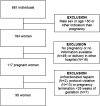Incidence of postpartum haemorrhage in women receiving therapeutic doses of low-molecular-weight heparin: results of a retrospective cohort study
- PMID: 22102641
- PMCID: PMC3221289
- DOI: 10.1136/bmjopen-2011-000257
Incidence of postpartum haemorrhage in women receiving therapeutic doses of low-molecular-weight heparin: results of a retrospective cohort study
Abstract
Background Low-molecular-weight heparin (LMWH) is the drug of choice to prevent venous thrombosis in pregnancy, but the optimal dose for prevention while avoiding bleeding is unclear. This study investigated whether therapeutic doses of LMWH increase the incidence of postpartum haemorrhage (PPH) in a retrospective controlled cohort. Methods All pregnant women who received therapeutic doses of LMWH between 1995 and 2008 were identified in the Academic Medical Center, Amsterdam, The Netherlands. The controls were women registered for antenatal care in the same hospital who did not use LMWH during pregnancy, matched by random electronic selection for age, parity and delivery date to LMWH users. The incidence of PPH (blood loss >500 ml), severe PPH (blood loss >1000 ml) and median blood loss were compared in two cohorts of LMWH users and non-users. Results The incidence of PPH was 18% in LMWH users (N=95) and 22% in non-users (N=524) (RR 0.8; 95% CI 0.5 to 1.4). The incidence of severe PPH was 6% in both groups (RR 1.2; 0.5 to 2.9). The median amount of blood loss differed only in normal vaginal deliveries. It was 200 ml in LMWH users and 300 ml in non-users (difference -100 ml; 95% CI -156 to -44). Conclusion Therapeutic doses of LMWH in pregnancy were observed not to be associated with a clinically meaningful increase in the incidence of PPH or severe PPH in women delivered in this hospital, although this observation may be confounded by the differential use of strategies to prevent bleeding. A randomised controlled trial is necessary to provide a definite answer about the optimal dose of LMWH in pregnancy.
Conflict of interest statement
Figures
Similar articles
-
The risk of postpartum hemorrhage in women using high dose of low-molecular-weight heparins during pregnancy.Thromb Res. 2012 Sep;130(3):334-8. doi: 10.1016/j.thromres.2012.03.007. Epub 2012 Apr 3. Thromb Res. 2012. PMID: 22475315
-
Low molecular weight heparin use during pregnancy and risk of postpartum hemorrhage: a systematic review and meta-analysis.J Matern Fetal Neonatal Med. 2019 Jun;32(11):1893-1900. doi: 10.1080/14767058.2017.1419179. Epub 2018 Jan 5. J Matern Fetal Neonatal Med. 2019. PMID: 29251025
-
[Thromboprophylaxis with low-molecular-weight heparin insufficient in high-risk pregnancy].Ned Tijdschr Geneeskd. 2011;155:A3433. Ned Tijdschr Geneeskd. 2011. PMID: 21527059 Dutch.
-
Aspirin or heparin or both for improving pregnancy outcomes in women with persistent antiphospholipid antibodies and recurrent pregnancy loss.Cochrane Database Syst Rev. 2020 May 2;5(5):CD012852. doi: 10.1002/14651858.CD012852.pub2. Cochrane Database Syst Rev. 2020. PMID: 32358837 Free PMC article.
-
Low-molecular-weight heparin in pregnancy: peripartum bleeding complications.J Perinatol. 2007 Jun;27(6):329-34. doi: 10.1038/sj.jp.7211745. Epub 2007 Apr 19. J Perinatol. 2007. PMID: 17443203
Cited by
-
Bleeding in women with venous thromboembolism during pregnancy: A systematic review of the literature.Res Pract Thromb Haemost. 2022 Aug 29;6(6):e12801. doi: 10.1002/rth2.12801. eCollection 2022 Aug. Res Pract Thromb Haemost. 2022. PMID: 36051542 Free PMC article.
-
Standardizing definitions for bleeding events in studies including pregnant women: A call to action.Res Pract Thromb Haemost. 2022 Oct 25;6(7):e12822. doi: 10.1002/rth2.12822. eCollection 2022 Oct. Res Pract Thromb Haemost. 2022. PMID: 36313985 Free PMC article. No abstract available.
-
Application of the RCOG Risk Assessment Model for Evaluating Postpartum Venous Thromboembolism in Chinese Women: A Case-Control Study.Med Sci Monit. 2021 Jul 7;27:e929904. doi: 10.12659/MSM.929904. Med Sci Monit. 2021. PMID: 34230447 Free PMC article.
-
Utilization of venous thromboembolism prophylaxis in American hospitalized pregnant women undergoing cesarean section.Int J Clin Pharm. 2019 Feb;41(1):264-271. doi: 10.1007/s11096-018-00779-y. Epub 2019 Jan 19. Int J Clin Pharm. 2019. PMID: 30661217
-
Risk factors for severe postpartum hemorrhage: a case-control study.BMC Pregnancy Childbirth. 2017 Jan 10;17(1):17. doi: 10.1186/s12884-016-1217-0. BMC Pregnancy Childbirth. 2017. PMID: 28068990 Free PMC article.
References
-
- Bates SM, Greer IA, Pabinger I, et al. Venous thromboembolism, thrombophilia, antithrombotic therapy, and pregnancy: American College of Chest Physicians Evidence-Based Clinical Practice Guidelines (8th Edition). Chest 2008;133:844S–86S - PubMed
-
- World Health Organization Managing complications in pregnancy and childbirth: a guide for midwives and doctors. Integrated Management of Pregnancy and Childbirth 2003
-
- Kominiarek MA, Angelopoulos SM, Shapiro NL, et al. Low-molecular-weight heparin in pregnancy: peripartum bleeding complications. J Perinatol 2007;27:329–34 - PubMed
-
- Bais JM, Eskes M, Pel M, et al. Postpartum haemorrhage in nulliparous women: incidence and risk factors in low and high risk women. A Dutch population-based cohort study on standard (> or = 500 ml) and severe (> or = 1000 ml) postpartum haemorrhage. Eur J Obstet Gynecol Reprod Biol 2004;115:166–72 - PubMed
-
- Dildy GA., III Postpartum hemorrhage: new management options. Clin Obstet Gynecol 2002;45:330–44 - PubMed
LinkOut - more resources
Full Text Sources
Medical

